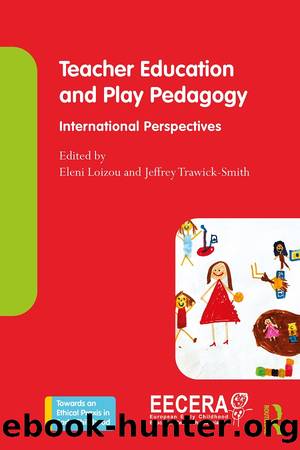Teacher Education and Play Pedagogy by Eleni Loizou & Jeffrey Trawick-Smith

Author:Eleni Loizou & Jeffrey Trawick-Smith
Language: eng
Format: epub
Publisher: Taylor and Francis
Published: 2022-10-15T00:00:00+00:00
Teacherâs Role in Supporting Pretend and Digital Play
In an educational context even free play allows for adults to participate. However, certain conditions need to be satisfied. An adult must not limit childrenâs freedom or set the rules that contradict their needs as this might destroy the play. A teacherâs participation is aimed to develop and enrich play, as well as maintain childrenâs play interest (Hännikainen, Singer, & van Oers, 2013; van Oers, 2013). Moderating childrenâs play is a skill that can be taught.
On the basis of the observation of children play, Fleer (2015) formulated a few parameters of a teacherâs actions and position in relation to an imaginary situation. Among those is physical proximity, as it makes the involvement into the play and its maintenance more natural. A study conducted by Singer confirmed the importance of the prolonged physical proximity of a teacher with a child of 2 to 3 years, which increased the engagement of a child (Singer, Nederend, Penninx, Tajik, & Boom, 2014). Conversely, negative effect was shown in the situation when an adult is only walking around children with little contact with them. Fleer (2015) described many examples of a teacher not being able to correctly understand and interpret childrenâs play because of physical distance. In other words, the teacherâs intentions were separated from the childrenâs. Alternatively, a teacherâs involvement can consist of active observation, expanding current themes of the play and suggesting new ones (Pyle & Danniels, 2017). A teacher can also participate by discussing with children the imaginary situation within play. At last, a teacher can be fully involved in the play. Hännikainen and colleagues (2013) introduced the criteria for successful involvement of an adult into a childrenâs role play. First, the idea of play should be derived from the children, while the adult actively participates, discusses, and helps develop the play. An adult should play and live the role; he or she needs to be emotionally involved; an adult joins spontaneous dialogues while playing the character and acts as a play partner for children. Another criterion is that an adult supports dramatic tension of a narrative and helps build cohesive and engaging storyline. Lastly, an adult should maintain the dynamics of play and childrenâs involvement; when they are bored, an adult can introduce a new character or a plot twist (Hännikainen et al., 2013).
We suggest that the same principles can be applied to digital play guidance. Physical proximity to a child playing with a device makes a teacher more informed of the childâs actions and more available for communication. A teacher can participate by discussing with the children about their experiences and strategies in digital play. Also, the teacher can be fully involved in digital play as a second player.
Smirnova (2017) introduced and elaborated the concept of âplay competence of a teacherâ regarding pretend play. The supportive position of a teacher means that s/he encourages childrenâs initiative in play. The teacher both participates and organizes play. The degree and nature of the teacherâs involvement depends on the situation and childrenâs playing skills.
Download
This site does not store any files on its server. We only index and link to content provided by other sites. Please contact the content providers to delete copyright contents if any and email us, we'll remove relevant links or contents immediately.
CCNA Cisco Certified Network Associate Exam (200-301): Technology Workbook by IP Specialist(521)
Learning First, Technology Second by Liz Kolb(517)
Passionate Readers by Pernille Ripp(493)
Presenting: The Professor's Guide to Powerful Communication by Norman Eng(479)
The SEO Book: Search Engine Optimization 2020, Free SEO Audit incl., Way to Nr. 1, SEO and SEM by Tobias Ebner & Granitza Levin(451)
Guide to Teaching Computer Science by Orit Hazzan Tami Lapidot & Noa Ragonis(440)
Google Classroom: 2019 User Manual to Learn Everything You Need to Know About Google Classroom by Class Alexa(414)
The Math(s) Fix: An Education Blueprint for the AI Age by Wolfram Conrad(382)
Web-Based Learning by Gayle V. Davidson-Shivers Karen L. Rasmussen & Patrick R. Lowenthal(374)
Research on Mathematics Textbooks and Teachers’ Resources by Lianghuo Fan Luc Trouche Chunxia Qi Sebastian Rezat & Jana Visnovska(369)
Advanced Apple Debugging by 2018(368)
Guide to Teaching Puzzle-based Learning by Edwin F. Meyer Nickolas Falkner Raja Sooriamurthi & Zbigniew Michalewicz(343)
Computational Thinking in the STEM Disciplines by Myint Swe Khine(334)
Video in the Age of Digital Learning by Jonas Köster(329)
Mastering Basic Acupuncture by Shripad Chodankar(322)
Digital Workplace Learning by Dirk Ifenthaler(321)
Creativities, Technologies, and Media in Music Learning and Teaching (Oxford Handbooks) by Gary E. McPherson & Graham F. Welch(315)
Deeper Learning With QR Codes and Augmented Reality by Monica Burns(290)
Digital Tools in Urban Schools: Mediating a Remix of Learning by Mahiri Jabari(288)
